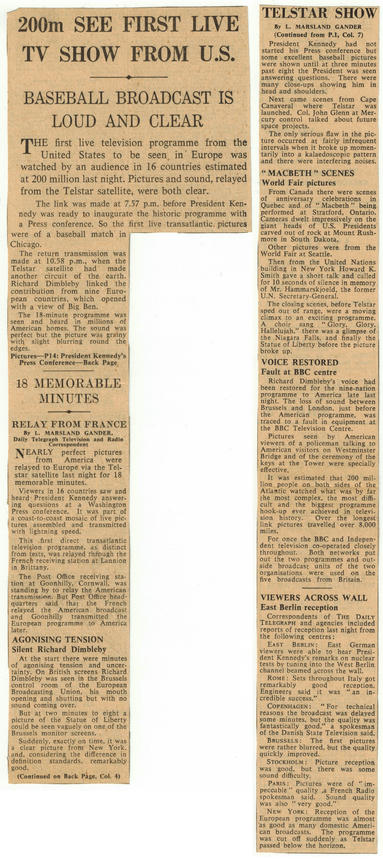Scrapbook 3: 200m See First Live TV Show From U.S., Telstar Show

200m SEE FIRST LIVE TV SHOW FROM U.S.
BASEBALL BROADCAST IS LOUD AND CLEAR
THE first live television programme from the United States to be seen in Europe was watched by an audience in 16 countries estimated at 200 million last night. Pictures and sound, relayed from the Telstar satellite, were both clear.
The link was made at 7.57 p.m. before President Kennedy was ready to inaugurate the historic programme with a Press conference. So the first live transatlantic pictures were of a baseball match in Chicago.
The return transmission was made at 10.58 p.m., when the Telstar satellite had made another circuit of the earth. Richard Dimbleby linked the contribution from nine European countries, which opened with a view of Big Ben.
The 18-minute programme was seen and heard in millions of American homes. The sound was perfect but the picture was grainy with slight blurring round the edges.
Pictures—P14; President Kennedy’s Press Conference—Back Page
18 MEMORABLE MINUTES
RELAY FROM FRANCE
By L. MARSLAND GANDER, Daily Telegraph Television and Radio Correspondent
NEARLY perfect pictures from America were relayed to Europe via the Telstar satellite last night for 18 memorable minutes.
Viewers in 16 countries saw and heard President Kennedy answering questions at a Washington Press conference. It was part of a coast-to-coast mosaic of live pictures assembled and transmitted with lightning speed.
This first direct transatlantic television programme, as distinct from tests, was relayed through the French receiving station at Lannion in Brittany.
The Post Office receiving station at Goonhilly, Cornwall, was standing by to relay the American transmission. But Post Office headquarters said that the French relayed the American broadcast and Goonhilly transmitted the European programme to America later.
AGONISING TENSION
Silent Richard Dimbleby
At the start there were minutes of agonising tension and uncertainty. On British screens Richard Dimbleby was seen in the Brussels control room of the European Broadcasting Union, his mouth opening and shutting but with no sound coming over.
But at two minutes to eight a picture of the Statue of Liberty could be seen vaguely on one of the Brussels monitor screens.
Suddenly, exactly on time, it was a clear picture from New York, and, considering the difference in definition standards, remarkably good.
(Continued on Back Page, Col. 4)
TELSTAR SHOW
By L. MARSLAND GANDER
(Continued from P.1, Col. 7)
President Kennedy had not started his Press conference but some excellent baseball pictures were shown until at three minutes past eight the President was seen answering questions. There were many close-ups showing him in head and shoulders.
Next came scenes from Cape Canaveral where Telstar was launched. Col. John Glenn at Mercury control talked about future space projects.
The only serious flaw in the picture occurred at fairly infrequent intervals when it broke up momentarily into a kalaedoscopic pattern and there were interfering noises.
“MACBETH” SCENES
World Fair pictures
From Canada there were scenes of anniversary celebrations in Quebec and of “Macbeth” being performed at Stratford, Ontario. Cameras dwelt impressively on the giant heads of U.S. Presidents carved out of rock at Mount Rushmore in South Dakota.
Other pictures were from the World Fair at Seattle.
Then from the United Nations building in New York Howard K. Smith gave a short talk and called for 10 seconds of silence in memory of Mr. Hammarskjoeld, the former U.N. Secretary-General.
The closing scenes, before Telstar sped out of range, were a moving climax to an exciting programme. A choir sang “Glory, Glory, Hallelujah,” there was a glimpse of the Niagara Falls, and finally the Statue of Liberty before the picture broke up.
VOICE RESTORED
Fault at BBC centre
Richard Dimbleby’s voice had been restored for the nine-nation programme to America late last night. The loss of sound between Brussels and London, just before the American programme, was traced to a fault in equipment at the BBC Television Centre.
Pictures seen by American viewers of a policeman talking to American visitors on Westminster Bridge and of the ceremony of the keys at the Tower were specially effective.
It was estimated that 200 million people on both sides of the Atlantic watched what was by far the most complex, the most difficult and the biggest programme hook-up ever achieved in television history. Over the longest link pictures travelled over 8,000 miles.
For once the BBC and Independent television co-operated closely throughout. Both networks put out the two programmes and outside broadcast units of the two organisations were used on the five broadcasts from Britain.
VIEWERS ACROSS WALL
East Berlin reception
Correspondents of THE DAILY TELEGRAPH and agencies included reports of reception last night from the following centres:
EAST BERLIN: East German viewers were able to hear President Kennedy’s remarks on nuclear tests by tuning into the West Berlin channel beamed across the wall.
ROME: Sets throughout Italy got remarkably good reception. Engineers said it was “an incredible success.”
COPENHAGEN: “For technical reasons the broadcast was delayed some minutes, but the quality was fantastically good,” a spokesman of the Danish State Television said.
BRUSSELS: The first pictures were rather blurred, but the quality quickly improved.
STOCKHOLM: Picture reception was good, but there was some sound difficulty.
PARIS: Pictures were of “impeccable” quality ,a French Radio spokesman said. Sound quality was also “very good.”
NEW YORK: Reception of the European programme was almost as good as many domestic American broadcasts. The programme was cut off suddenly as Telstar passed below the horizon.